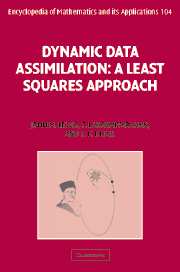Book contents
- Frontmatter
- Contents
- Preface
- Acknowledgements
- PART 1 GENESIS OF DATA ASSIMILATION
- PART II DATA ASSIMILATION: DETERMINISTIC/STATIC MODELS
- PART III COMPUTATIONAL TECHNIQUES
- PART IV STATISTICAL ESTIMATION
- PART V DATA ASSIMILATION: STOCHASTIC/STATIC MODELS
- PART VI DATA ASSIMILATION: DETERMINISTIC/DYNAMIC MODELS
- PART VII DATA ASSIMILATION: STOCHASTIC/DYNAMIC MODELS
- PART VIII PREDICTABILITY
- Epilogue
- References
- Index
Epilogue
Published online by Cambridge University Press: 18 December 2009
- Frontmatter
- Contents
- Preface
- Acknowledgements
- PART 1 GENESIS OF DATA ASSIMILATION
- PART II DATA ASSIMILATION: DETERMINISTIC/STATIC MODELS
- PART III COMPUTATIONAL TECHNIQUES
- PART IV STATISTICAL ESTIMATION
- PART V DATA ASSIMILATION: STOCHASTIC/STATIC MODELS
- PART VI DATA ASSIMILATION: DETERMINISTIC/DYNAMIC MODELS
- PART VII DATA ASSIMILATION: STOCHASTIC/DYNAMIC MODELS
- PART VIII PREDICTABILITY
- Epilogue
- References
- Index
Summary
It is inspiring to view data assimilation from that epochal moment two hundred years ago when the youthful Carl Friedrich Gauss experienced an epiphany and developed the method of least squares under constraint. In light of the great difficulty that stalwarts such as Laplace and Euler experienced in orbit determination, Gauss certainly experienced the joie de vivre of this creative work. Nevertheless, we suspect that even Gauss could not have foreseen the pervasiveness of his discovery.
And, indeed, it is difficult to view data assimilation aside from dynamical systems – that mathematical exploration commenced by Henri Poincaré in the pre-computer age. Gauss had the luxury of performing least squares on a most stable and forgiving system, the two-body problem of celestial mechanics. Poincare and his successors, notably G. D. Birkhoff and Edward Lorenz, made it clear that the three-body problem was not so forgiving of slight inaccuracies in initial state – evident through their attack on the special three-body problem discussed earlier. Further, the failure of deterministic laws to explain Brownian motion and the intricacies of thermodynamics led to a stochastic–dynamic approach where variables were considered to be random rather than deterministic. In this milieu, probability melded with dynamical law and data assimilation expanded beyond the Gaussian scope.
- Type
- Chapter
- Information
- Dynamic Data AssimilationA Least Squares Approach, pp. 628 - 629Publisher: Cambridge University PressPrint publication year: 2006

